How to Enable Administrator Account in Windows 10 Pro Without Admin Rights
Full Fix: Disabled administrator account on Windows 10
Passionate about all elements related to Windows and combined with his innate curiosity, Ivan has delved deep into understanding this operating system, with a specialization in drivers and driver troubleshooting. When he's not tackling... Read more
Updated: Posted: March 2018
- For pretty much every change you wish to make to your PC, you are asked to run the respective program as administrator. It's easy to see why having administrative rights over your system is a big deal.
- If you're facing a Disabled Administrator Account on Windows 10, then search no more. The right solutions to quickly fix this are listed below, at your disposal.
- After having quickly enabled the Admin account, it's time for you to deal with all the other pesky System Errors that hinder your workflow. Learn how to do that here.
- Finally, become a Windows 10 subject matter expert by exploring our Windows 10 errors hub and make sure no issue can stand in your way.

XINSTALL BY CLICKING THE DOWNLOAD FILE
Our Windows accounts can break for some reason, but one of the most inconvenient problems is the disabled Administrator account on Windows 10.
Although this can be a big problem, there are few ways to fix it.
How can I fix disabled Administrator account on Windows 10?
Many users reported problems with a disabled administrator account. This can be a big issue since you won't be able to login to your account at all.
In order to help you with this problem, in this article we're going to cover the following problems:
- Enable administrator account Windows 10 without logging in, Home edition, regedit, without admin rights – There are several ways to enable administrator account on Windows 10. You can do it without logging in by using Command Prompt. You can also enable administrator account in the Home version of Windows by using regedit.
- Enable administrator account Powershell, Command Prompt, Group Policy – There are several ways to enable administrator account on Windows 10, and if you're tech-savvy, you can do that in a matter of moments using Powershell or Command Prompt. In addition, you can also enable administrator account by modifying Group Policy.
- Disabled administrator account Safe mode – If you can't access your account normally, you might be able to circumvent this issue by using Safe Mode.
- Your administrator account has been disabled Windows 10 – This is another common error that can appear on your PC. However, you should be able to fix this error by using one of our solutions.
- Enable administrator account access denied, locked out – Many users reported that they are locked out of their account. If this happens, you'll get Access denied message whenever you try to access your account.
According to the users, when they try to login to Windows 10, they see their Administrator account, but when they click it, there's no input field to enter a password.
Instead, they are getting the message that says Your account has been disabled. Please see your system administrator. This can be quite a problem, but there are several solutions available.
Learn everything there is to know about the administrator account and how you can enable/disable it right here!
1) Enter the Safe Mode
If your administrator account is disabled, you might be able to fix it by going to Safe Mode.
Safe Mode is a special section of Windows that runs with default settings, and even if your administrator account is disabled, you should be able to access Safe Mode.
To enter Safe Mode, you need to do the following:
- On the login screen, click the Power button. Press and hold the Shift key and choose Restart from the menu. If you can't get to the login screen, restart your PC a few times during the boot sequence until you start the Automatic Repair process.
- Now select Troubleshoot > Advanced options > Startup Settings. Now click the Restart button.
- Once your computer restarts, you'll be presented with a list of options. Press the appropriate key to select the desired version of Safe Mode. In our opinion, it's best to use Enable Safe Mode with Networking.
After doing that, Safe Mode should start. Once you enter Safe Mode, you should be able to apply some of our solutions in order to enable your Administrator account once again.
Safe mode not working in Windows 10? Don't panic! Here is how to fix the issue!
2) Use lusrmgr.msc to fix the problem
In order to do this, you will need to access Windows 10 as another user or through Safe Mode. If you cannot access Windows 10 in any way skip this solution.
- Press Windows Key + R and, type lusrmgr.msc and press Enter to run it.
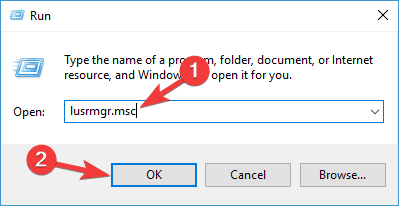
- Lusrmgr should open. Click on Users and double click on the problematic account.

- When Properties windows open, make sure that Account is a disabled option isn't checked. Click Apply and OK to save the changes and restart your computer.
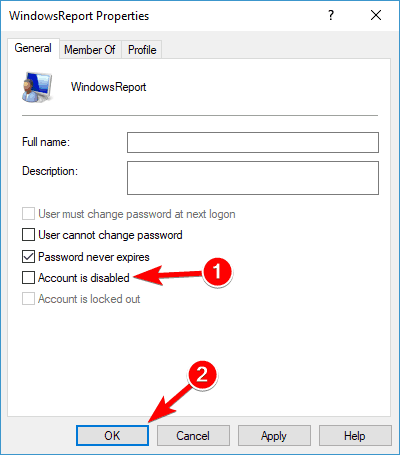
After doing that, you should be able to access your administrator account again.
3) Use command prompt to activate Administrator account
- On the login screen press and hold the Shift key and then click on Restart. This should boot you to advanced boot.
- From there you need to click Troubleshoot > Advanced options > Command Prompt.
- When Command Prompt opens, type the following line and press Enter to run it:
- net user administrator /active:yes

- net user administrator /active:yes
- Restart your computer and see if the issue is resolved.
If this doesn't work, you can try the following:
Follow steps 1 and 2 to open the Command Prompt. After Command Prompt has started you need to do the following:
- In the Command Prompt type regedit and press Enter. This should start Registry Editor.

- When Registry Editor starts, click on the HKEY_LOCAL_MACHINE key in the left pane.
- Now click the File from the menu bar and click on Load Hive.
- Open the drive where Windows 10 is installed (by default it should be C, but it might be different) and go to the following path:
-
C:WindowsSystem32config
-
- Select the SAM file and click on Open.
- In the Load Hive dialog type REM_SAM and click OK.
- In the left pane of Registry Editor go to the following key:
-
HKEY_LOCAL_MACHINESAMSAMDomainsAccountsUsers00001F4
-
- In the right pane of 000001F4 key double click on the F binary value.
- In line 0038, change 11 to 10 and click OK.
- Close Registry Editor and Command Prompt.
- Click Continue to start Windows 10 again.
After making these changes, your administrator account should become enabled once again.
Expert Tip: Some PC issues are hard to tackle, especially when it comes to corrupted repositories or missing Windows files. If you are having troubles fixing an error, your system may be partially broken. We recommend installing Restoro, a tool that will scan your machine and identify what the fault is.
Click here to download and start repairing.
Become an expert on Command Prompt! Read our complete guide!
4) Use Group Policy Editor
If you have a disabled administrator account on your PC, you might be able to fix the problem by making a few changes in Group Policy Editor.
If you're not familiar, Group Policy Editor is a powerful tool that allows you to configure various policies.
Using this tool you can modify various security policies including ones related to your administrator account. We have to mention that this tool isn't available in Home versions of Windows by default, but there's a way to enable it.
To see how to do that, be sure to check our article on how to enable Group Policy Editor in the Home version of Windows 10. To enable the administrator account using Group Policy Editor, you need to do the following:
- Press Windows Key + R and enter gpedit.msc. Press Enter or click OK.

- When Group Policy Editor opens, navigate to
Computer Configuration > Windows Settings > Security Settings > Local Policies > Security OptionsIn the right pane, double click Accounts: Administrator account status.
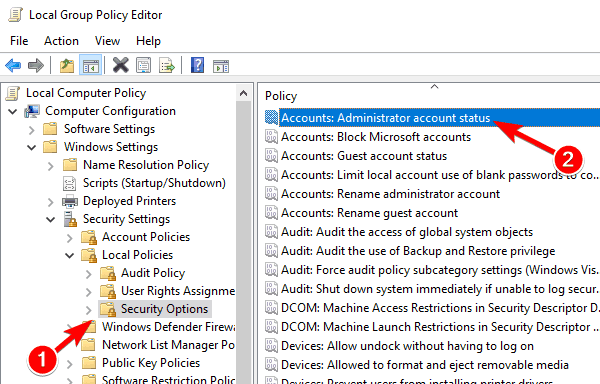
- When the Properties window opens, select Enabled and click Apply and OK.

After doing that, the hidden administrator account will be enabled and you'll be able to access it without any problems.
Still not sure how to edit in Group Policy Editor? Don't worry, we got your back with a step-by-step guide!
5) Enable hidden administrator account from PowerShell
Another way to enable disabled administrator account is to use PowerShell.
If you're not familiar, PowerShell is a command-line tool similar to Command Prompt, but unlike Command Prompt, it comes with some advanced features.
To enable administrator account using PowerShell, do the following:
- Start PowerShell as administrator. To do that, simply press Windows Key + X shortcut and choose PowerShell (Admin) from the menu. If PowerShell isn't available, you can start it by pressing Windows Key + S and entering powershell in the Search field. Right-click Windows PowerShell from the list and choose Run as administrator.
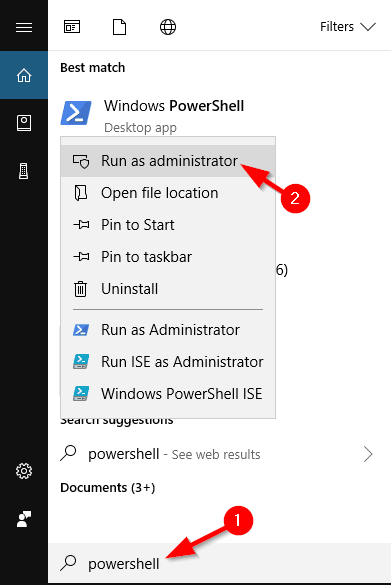
- When PowerShell starts, enter Enable-LocalUser -Name "Administrator" and press Enter.

After doing that, the administrator account should become available and you'll be able to access it. If you need to disable the administrator account, you can do it using the Disable-LocalUser -Name "Administrator" command.
Keep in mind that this command might not work if you're using a non-English version of Windows.
6) Create a new user account
If your administrator account is disabled, you might be able to fix the problem by creating a new user account. To do that, just follow these steps:
- Press Windows Key + I to open the Settings app.
- Now navigate to the Accounts section.

- Select Family & other people from the menu on the left. In the right pane, click Add someone else to this PC.

- Click I don't have this person's sign-in information.

- Now choose to Add a user without a Microsoft account.

- Enter the desired name and click Next.
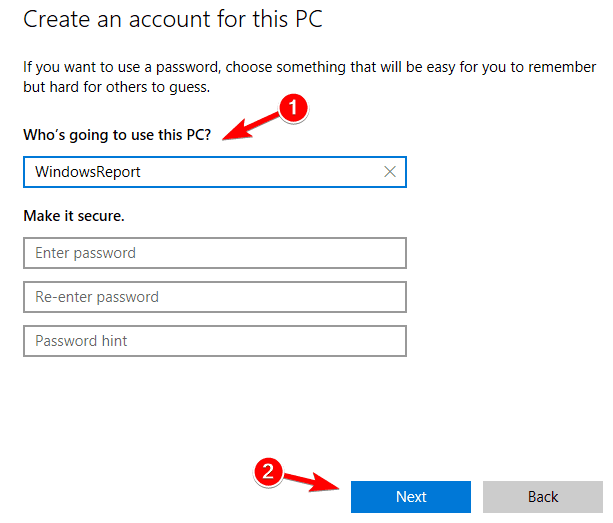
Now you just need to convert the new account to the administrator account. To do that, follow these steps:
- Go to Settings > Accounts.
- Go to Family & other people in the left pane. In the right pane, select the new account and click Change account type.

- Now change the Account type to Administrator and click on OK.
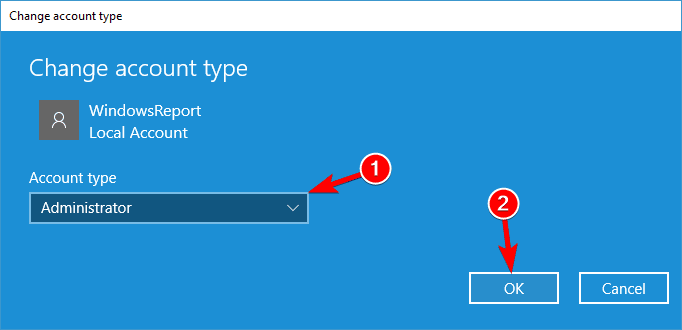
After doing that, you should be able to log in to the new account without any problems.
Windows won't let you add a new user account? Have no fear! Here is our guide to fix the issue!
That's all, you now know how to enable the Administrator account on Windows 10.
If you have any comments or questions, or you maybe know some other method on how to solve the disabled Administrator account problem in Windows 10, just reach for the comments below.
Frequently Asked Questions
-
Go to Start ->Settings ->Accounts and check the Administrator account. Select Properties -> uncheck Account is disabled. Check out this step-by-step guide for the complete procedure.
-
Open the program that prompts you to login with admin privileges by right-clicking its icon, then select Properties. Now, either click on Advanced and check Run As Administrator.
-
Open the Control Panel -> System and Security -> Security and Maintenance. Press the arrow to expand the options under Security. The User Account Control is by default on. Click Change settings and adjust from always notify to never notify.
![]()
Newsletter
How to Enable Administrator Account in Windows 10 Pro Without Admin Rights
Source: https://windowsreport.com/disabled-administrator-account-on-windows-10-fix/

0 Response to "How to Enable Administrator Account in Windows 10 Pro Without Admin Rights"
Post a Comment